Trees
“River Birch” has been added to your cart. View cart
Showing 17–23 of 23 results
-
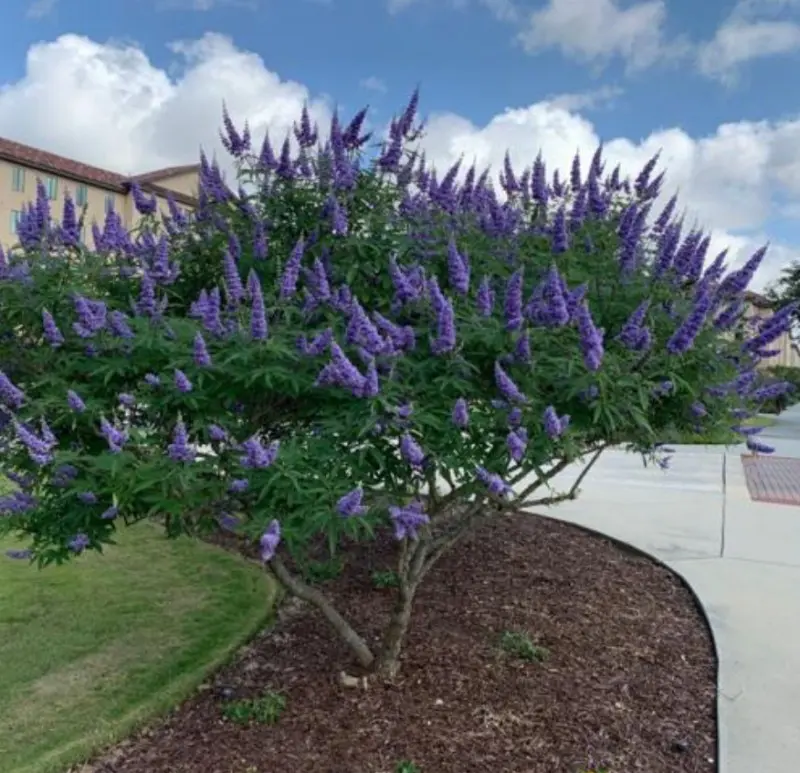
Purple Vitex
$0.00Add to LawnDeciduous (loose leave in winter)Up to 15'Grow up to 24" per year-Purple Vitex (Vitex agnus-castus), also known as Chaste Tree or Texas Lilac, is a fast-growing deciduous shrub or small tree prized for its spiked clusters of fragrant purple flowers. Blooming from late spring through summer, these showy, lavender-to-deep-purple flowers attract pollinators like butterflies, bees, and hummingbirds, bringing life and color to the landscape. The long, slender flower spikes create a lilac-like appearance, which is why Vitex is often called “Texas Lilac” in southern regions. Purple Vitex typically reaches a height of 10 to 20 feet with a similar spread, making it a great choice for a flowering tree or large shrub in the garden. It has a naturally vase-like shape with aromatic, gray-green, palmate leaves that add texture and contrast to the landscape. Hardy in USDA zones 6-9, Purple Vitex thrives in full sun and well-draining soil and is highly drought-tolerant once established, making it well-suited to hot and dry climates. This low-maintenance plant benefits from occasional pruning in late winter to remove deadwood and encourage a bushier shape or control its size. Deadheading spent flowers can also extend its blooming period. Purple Vitex is deer-resistant, generally pest-free, and adaptable to various soil conditions, making it ideal for low-water or xeriscape gardens. With its showy purple blooms, fragrant foliage, and tolerance to heat and drought, Purple Vitex adds a bold, Mediterranean feel to the garden and works beautifully as a specimen plant, hedge, or mixed border addition. -

Red Maple
$0.00Add to LawnDeciduous (loose leaves in winter)Up to 50'Grow up to 24" per year-Red Maple (Acer rubrum), also known as Swamp Maple or Soft Maple, is a popular deciduous tree admired for its vibrant fall color, versatile growth, and adaptability to various soil conditions. Native to North America, this tree is known for its brilliant red, orange, or yellow foliage in the autumn, as well as its red flowers, seeds, and twigs in early spring, which add subtle color even before the leaves emerge. Red Maples are often one of the first trees to change color in the fall, creating a striking seasonal display. Red Maples typically grow to heights of 40 to 70 feet with a spread of 30 to 50 feet, making them ideal shade trees in residential and urban landscapes. They thrive in USDA zones 3-9 and adapt well to full sun or partial shade. While Red Maples are tolerant of a variety of soil types, including clay, loam, and sandy soils, they prefer slightly acidic, moist, and well-draining conditions. They can even tolerate occasional flooding, making them well-suited to wetland areas and low spots. Low-maintenance by nature, Red Maples require minimal pruning to remove deadwood and shape the tree if needed, usually in late winter or early spring. Resistant to many pests and diseases, they are relatively easy to care for and can live for several decades with proper care. With its rapid growth, striking seasonal color, and adaptability, the Red Maple is an excellent choice for adding year-round beauty, shade, and ecological value to the landscape. This tree brings structure and a dynamic color palette to both rural and urban settings, enhancing gardens, parks, and streetscapes alike. -
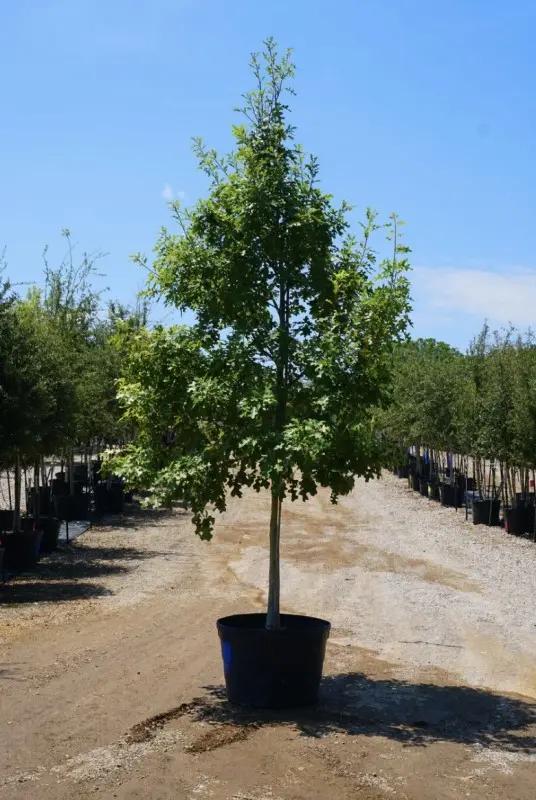
Red Oak
$0.00Add to LawnDeciduous (loose leaves in winter)Grow up to 24" per yearUp to 70'-Red Oak (Quercus rubra), also known as Northern Red Oak, is a majestic deciduous tree celebrated for its vibrant red to reddish-brown foliage in the fall and its strong, broad-spreading canopy. Native to North America, Red Oak has a straight trunk and dark gray bark with distinctive, shiny ridges. In spring, the tree produces small, yellowish-green catkins, while its large, lobed leaves turn to brilliant shades of red in autumn, making it a standout in any landscape. Red Oaks typically reach heights of 60 to 75 feet with a similar spread, creating a generous canopy that offers ample shade. They thrive in USDA zones 4-8, preferring full sun and well-draining soil with a slightly acidic to neutral pH. Red Oak trees are adaptable to various soil types, including sandy, clay, and loamy soils, and are moderately drought-tolerant once established. Their rapid growth rate and long lifespan make them ideal shade trees for parks, large residential properties, and open landscapes. Low-maintenance and hardy, Red Oaks require minimal pruning aside from removing dead or damaged branches in late winter. They are generally resistant to pests and diseases, though young trees may benefit from mulching and occasional watering during dry spells. With their stunning fall color, dense canopy, and robust form, Red Oaks are favored for adding structure, shade, and seasonal interest to landscapes, contributing both ecological and aesthetic value for generations. -
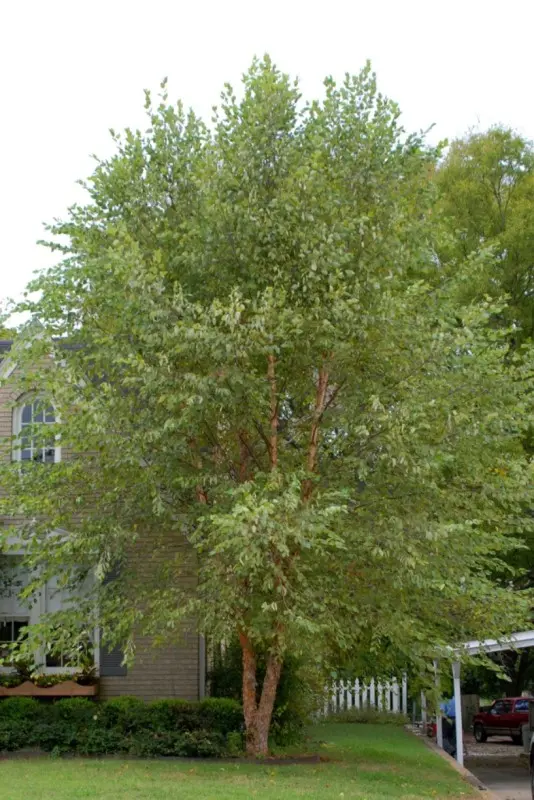
River Birch
$0.00Add to LawnDeciduous (loose leaves in winter)Up to 70'Grow up to 24" per year-River Birch (Betula nigra) is a hardy, fast-growing deciduous tree known for its attractive peeling bark, disease resistance, and adaptability to wet soils. Native to the eastern United States, River Birch has distinctive cinnamon-colored bark that peels in papery layers, revealing lighter bark underneath, which adds year-round visual interest, particularly in winter. Its foliage emerges in a vibrant green in spring, turns yellow in the fall, and forms a dense canopy that provides excellent shade. Typically reaching heights of 40 to 70 feet with a spread of 30 to 50 feet, River Birch is well-suited for larger landscapes, wetland areas, and erosion control along riverbanks or ponds. It thrives in USDA zones 4-9 and performs best in full sun to partial shade. While it is highly tolerant of wet and poorly draining soils, River Birch is also adaptable to drier conditions once established, though it will benefit from consistent moisture in dry climates. River Birch requires minimal maintenance, with occasional pruning to remove any dead or crossing branches, ideally done in late fall or winter to prevent sap bleeding. It is naturally resistant to pests and diseases, including the bronze birch borer, making it a popular alternative to other birch species in warmer and more humid regions. With its distinctive bark, lush foliage, and resilience, River Birch is a favorite for naturalized and formal landscapes alike. It provides a unique blend of beauty and function, serving as a stunning focal point, shade tree, or erosion control solution in wet areas. -
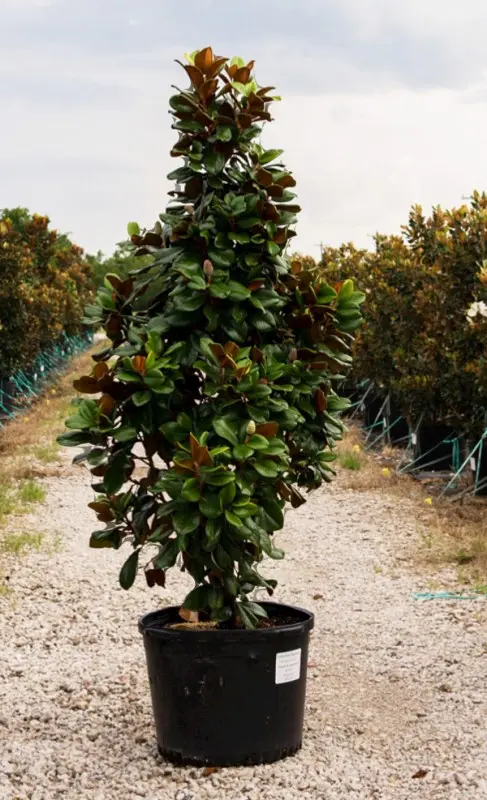
Teddy Bear Magnolia
$0.00Add to LawnEvergreenUp to 40'Can grow 24" per year-Teddy Bear Magnolia (Magnolia grandiflora ‘Southern Charm’), also known as Little Gem Magnolia, is a compact, evergreen tree prized for its glossy, dark green leaves with a distinctive fuzzy brown underside and large, fragrant white flowers. Native to the southern United States, this smaller variety of Southern Magnolia is ideal for smaller landscapes or as an accent tree, adding elegance without overwhelming a space. The blooms are classic magnolia—large, creamy white, and richly scented—appearing in late spring and sporadically throughout summer. Teddy Bear Magnolia typically grows to about 12 to 20 feet tall and 6 to 8 feet wide, with a naturally dense, upright, and pyramidal shape. It thrives in USDA zones 7-9, performing best in full sun to partial shade. The tree prefers well-draining, slightly acidic soil, though it can adapt to a variety of soil types if given proper drainage. Once established, it is moderately drought-tolerant, making it a resilient option for both residential and urban landscapes. Low-maintenance and relatively slow-growing, Teddy Bear Magnolia may benefit from occasional pruning to maintain its shape or control size, though its naturally compact form requires minimal intervention. Its dense foliage and upright growth habit make it suitable for narrow spaces, privacy screens, or as a standalone specimen. With its evergreen leaves, beautiful blooms, and manageable size, Teddy Bear Magnolia brings classic Southern charm to gardens while fitting comfortably into smaller spaces. -
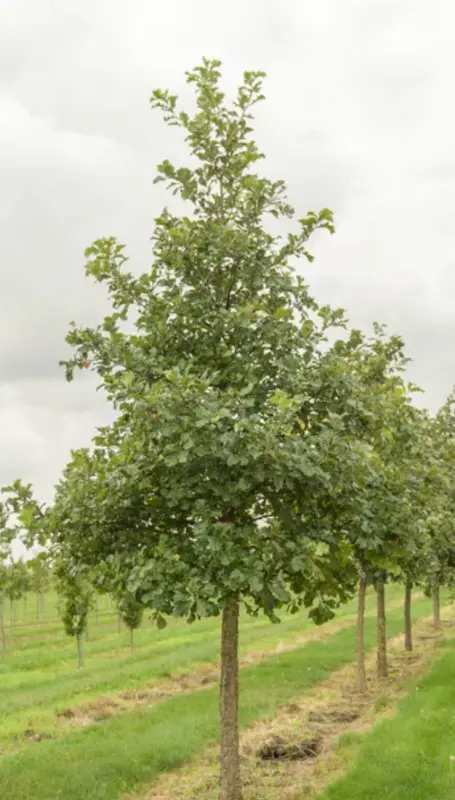
White Oak
$0.00Add to LawnDeciduous (loose leaves in winter)Grown up to 12" per yearUp to 70'-White Oak (Quercus alba) is a majestic, long-lived deciduous tree known for its stately form, broad canopy, and vibrant fall color. Native to eastern North America, White Oak is celebrated for its strong wood, attractive bark, and adaptability to a range of environments. It typically has large, deeply lobed leaves that emerge a light green in spring, mature to a dark blue-green in summer, and turn stunning shades of red, bronze, and burgundy in the fall. The tree’s bark is a light, ashy gray with a slightly scaly texture, adding a distinguished look year-round. White Oaks can reach heights of 60 to 80 feet with a similar spread, forming a rounded, dense canopy that provides ample shade. They thrive in USDA zones 3-9 and prefer full sun, performing best in well-draining, slightly acidic to neutral soils. White Oaks are moderately tolerant of drought once established and can adapt to various soil types, though they are best suited to loamy or sandy soils in natural woodland or open landscapes. With minimal maintenance needs, White Oaks are generally pest- and disease-resistant, though young trees benefit from mulching and occasional watering during dry periods. They require little pruning beyond removing dead or damaged wood. White Oaks produce acorns that serve as a valuable food source for wildlife, including squirrels, deer, and birds, enhancing biodiversity in the landscape. With its iconic presence, seasonal beauty, and ecological value, the White Oak is a timeless choice for large properties, parks, and rural landscapes, bringing structure, shade, and natural beauty to the environment for centuries. -

Willow Tree
$0.00Add to LawnDeciduous (loose leaves in winter)Grown up to 24" per yearUp to 50'-Willow Tree (Salix spp.), especially well-known in its Weeping Willow variety (Salix babylonica), is a graceful, deciduous tree admired for its long, cascading branches, slender leaves, and serene presence in landscapes. Native to various regions around the world, Willows are typically found near water sources, as they thrive in moist, well-draining soils. The weeping branches of the Willow create a soft, flowing effect, with narrow, light green leaves that turn yellow in the fall, adding seasonal beauty to the tree’s delicate silhouette. Willows typically grow between 30 to 50 feet in height with a similar spread, creating a broad, rounded canopy that provides ample shade. They thrive in USDA zones 4-9 and prefer full sun to partial shade. Known for their fast growth, Willow trees are often planted near ponds, streams, or other water features, where they add both aesthetic and ecological value by stabilizing soil and providing habitat for various wildlife species. They can tolerate various soil types but are especially suited to wet areas where other trees may struggle. Low-maintenance overall, Willows may need occasional pruning to remove deadwood and maintain a healthy shape, especially if grown near walkways or structures, as their branches can grow low to the ground. Due to their extensive root systems, they should be planted away from foundations, water pipes, and septic systems. With their iconic weeping form, soothing presence, and adaptability to wet soils, Willow Trees are popular choices for creating tranquil, natural-looking landscapes, offering shade, beauty, and ecological benefits to a variety of settings.

